 |
|
|
|
|

|
|
|
|
|
|
LIGHTING EXAMPLES
|
|
|
|
|
|
Click on Thumbnails to view large images
|
|
|
|
|
|
|
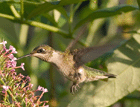
|
Direct
Sunlight - Late Afternoon
This image was taken in direct
sunlight about 2½ hours before sunset. Shutter 1/500, f/8,
ISO 400. Canon 10D, 400mm 5.6L lens. This is a good example of
the classic problem faced when flash is not used. A larger
aperture produces a shallower depth of field and unless the
bird is aligned perfectly, some of the body will be out of
focus. However, this image also shows that direct sunlight can
produce acceptable images.
|
|
|
|
|
|
|
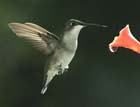
|
Direct Sunlight
- Mostly Backlit
This example was taken with the bird in
direct sunlight. ISO 3200, Shutter 1/3200 (Canon 10D). This bird was
mostly backlit, with some sunlight reflecting off the white
exterior of the house whose window I was shooting through.
This photo was significantly lightened in PS.
|
|
|
|
|
|
|
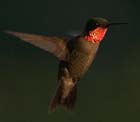
|
Direct, Late-Evening Sun
About 15-30 minutes before sunset. Shutter
1/2000, f/4, ISO 800. Because of the pose angle in relation to
the sun and the low light on the bird, the gorget is
highly emphasized.
|
|
|
|
|
|
|

|
Overcast
OK, so natural lighting isn't a problem when
the bird is perched. Notice the broad color distribution with
no gray. This is a result of the broadly diffused light
source, the whole sky.
|
|
|
|
|
|
|

|
Overcast
+ Hot Shoe Flash
This image was taken under the same basic conditions as the
"overcast" image, except a flash was used. The
background is different due to a different shooting position,
however, the difference in coloration of the feathers between
flash and natural light is the real story here. This green
hummingbird becomes bright gold when on-camera flash is used.
|
|
|
|
|
|
|

|
Hot Shoe Flash + Direct Sunlight
E-TTL with Canon 550ex and Better Beamer
Flash Extender. This bird was in my Mimosa tree and the fill
flash gave detail to the underside of the bird. It also
allowed me to close the aperture a little more than without
flash and gain a little DOF.
|
|
|
|
|
|
|

|
Hot Shoe Flash + Direct Sunlight
Another example with same settings as above.
|
|
|
|
|
|
|
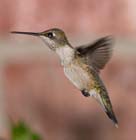
|
Hot Shoe Flash in mid-day shade
E-TTL, 580ex with Better Beamer. This bird
was on the shaded side of a house on a partly cloudy day. The
effect on the bird is markedly different than when the bird is
in a dark shade. The additional light from sky and clouds is
the difference. With my 400mm f/5.6 lens, this shot would have
been very difficult to achieve without flash.
|
|
|
|
|
|
|
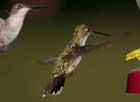
|
Hot Shoe Flash in dark shade
E-TTL, 550ex with Better Beamer. This photo
was taken under an open porch roof before a thunderstorm when
the sky was very dark. There was very little light other than
the flash. Under these conditions and in early morning and
late evening, specular highlights and uneven coloring of
feathers predominate.
|
|
|
|
|
|
|

|
Two (2) off-camera, hot shoe flashes with no
diffusion
I seldom use flashes without umbrellas or
small soft boxes. But, the results can work. With more flashes,
I could have closed the aperture more, used a lower ISO and
gotten rid of the ghost images of the wings. This shot was
taken in the shade of a tree in mid-afternoon on a sunny day.
Shutter 1/200, 2 Vivitar 283 flashes with VP-1, variable power
adapters set to 1/16 power. Incidentally, in this case, the
ghosting is not a result of the image of the wings so much as
it is a lower exposure of areas of the background due to the
travel of the wings between the background and the lens.
|
|
|
|
|
|
|
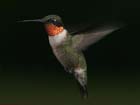
|
Two hot shoe flashes with umbrellas
Diffusing and spreading the light source
allows more of the hummingbird's feathers to show color and
decreases specular highlights allowing more color saturation.
Two 550ex flashes with white umbrellas. E-TTL mode with -1 2/3
flash exposure compensation. The drawback to E-TTL is the
pre-flash which can startle the birds.
|
|
|
|
|
|
|
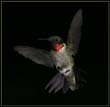
|
Two hot shoe flashes with umbrellas
This bird was startled by E-TTL pre-flash in
the same configuration as shot above. In fact, this is the
same hummingbird. Sometimes the pre-flash would bother the
bird, sometimes not. That is why I now use pc sync and
manually set flashes. Plus, a used Vivitar 283 or Sunpak 383
cost about 15 times less than a new Canon 580ex!
|
|
|
|
|
|
|

|
One umbrella, one homemade
soft box
A small soft box fitted on a hot shoe flash
can be positioned closer to the bird than an umbrella and
allows room for additional soft boxes, i.e., more light. The
overall lighting effect is about the same as an umbrella but
faster and easier to set up. The homemade soft boxes are
cheaper too. Notice the even coloration of the back of this
female. Compare this photo to the hot shoe flash and dark shade
photo above.
|
|
|
|
|
|
|
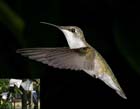
|
Four (4) small
soft boxes on four (4) flash units
My homemade soft boxes are shown in the inset. I
now make them to rest on top of the flash with the flash
pointed upward like the black one in the photo. This bird
drifted very close to the black soft box. I find that as the
evening light fades, the lighting of the birds in the photos improves a great
deal. The one drawback is that the background becomes
essentially black. My next project is to set up some better
backgrounds and flash the background too.
|
|
|
|
|
|
|

|
Two (2) small
soft boxes on three (3) flash units
(Longer
flash duration than above)
Setting
up four light stands with four flash units and four softboxes
finally wore me down. Then, during the winter when I had
plenty of time on my hands, it dawned on me that all I needed
was a bracket to put multiple flashes on. So I made one with a
corresponding softbox and, voila!, I only use two light stands
now. This shot also shows how a longer flash duration with
more light output will allow me to bring the background out of
complete darkness by shooting during midday (i.e., with a
brighter background) and still separate the bird from the
ghosting like in the shots without diffusers but still enjoy
the even lighting that I get from softboxes. I just get
more output from fewer softboxes with less assembled equipment
to carry around.
|
|
|
|
|
|
|
|
|
|
|
|
|
|
| |
|
|
|

